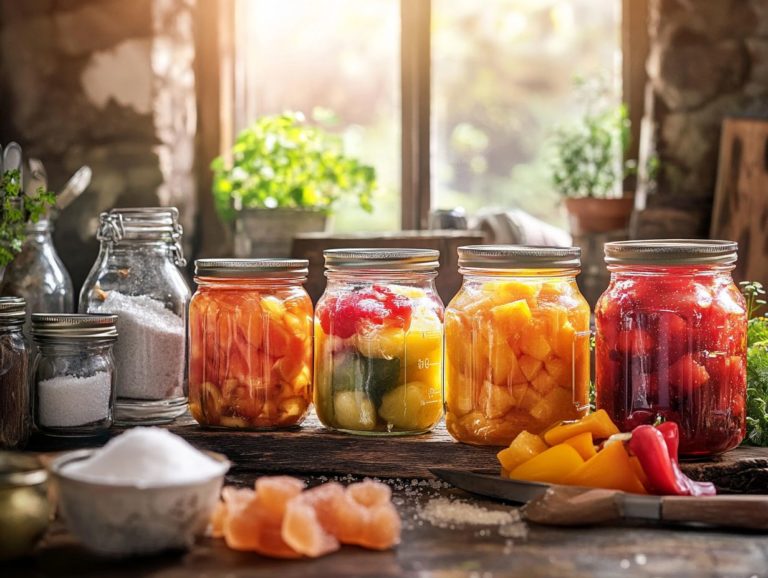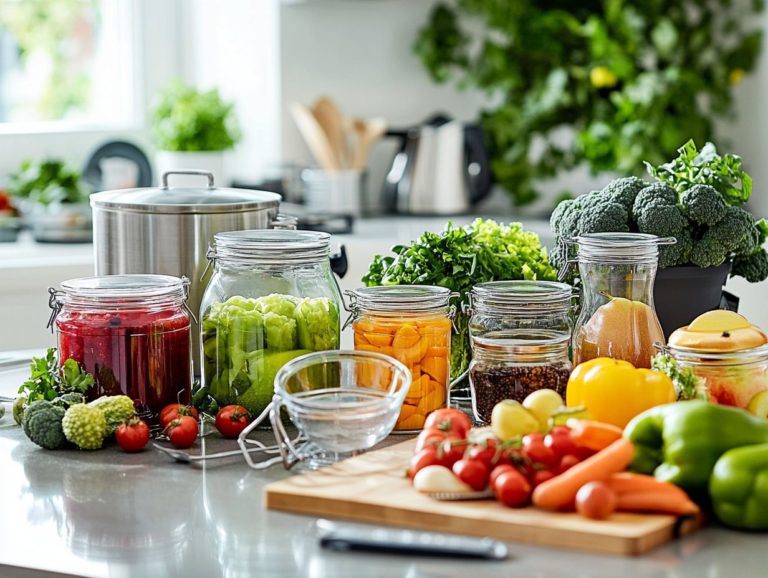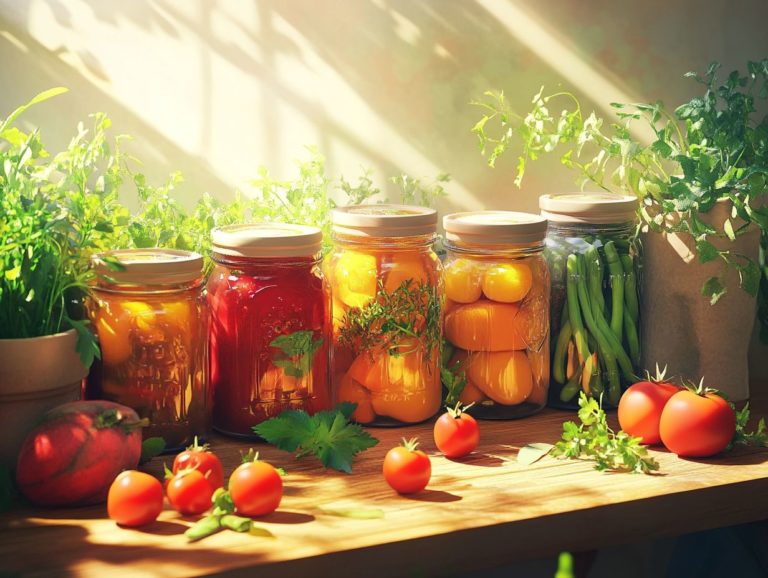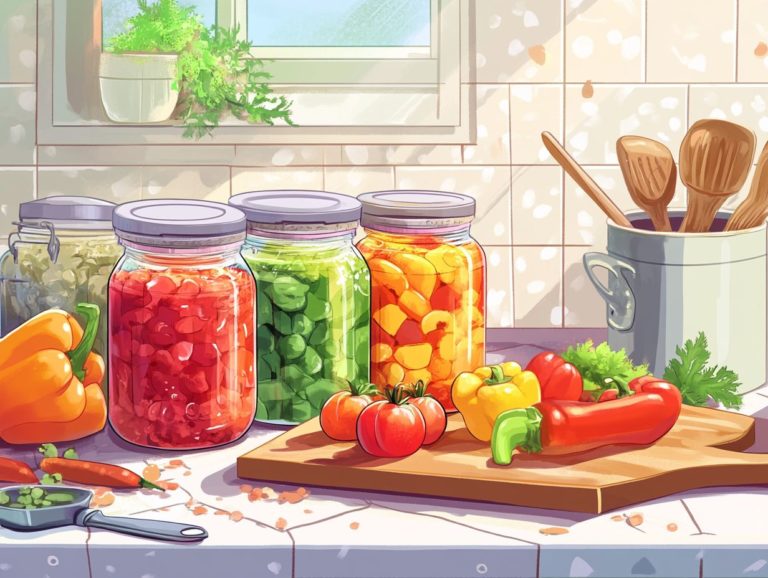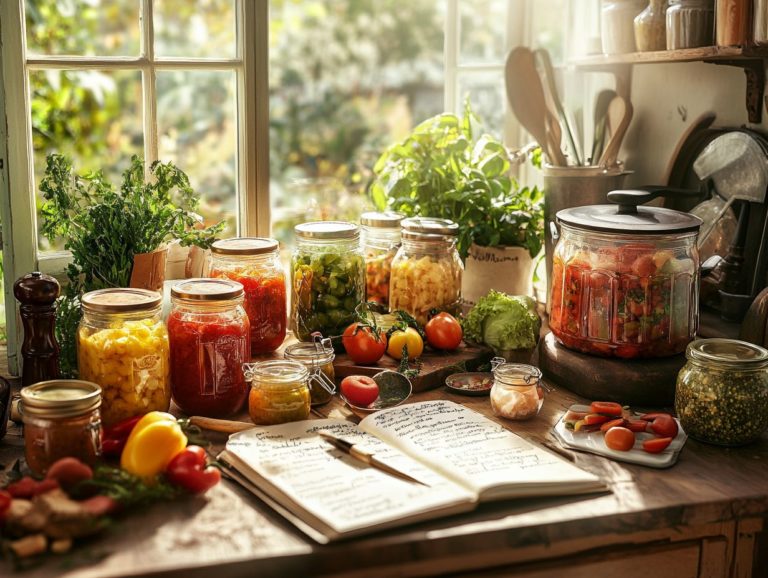How to Incorporate Herbs in Canning
Canning is a timeless preservation method that allows you to enjoy the foods you love all year round. When you incorporate herbs and spices, the results can be extraordinary.
This article explores various types of herbs that can elevate your canned goods, enhancing flavor and boosting nutrition. You will learn how to prepare and store herbs effectively, discover methods for adding dried herbs to your canning process, and find tips for achieving the best results.
You will also find tantalizing recipes that showcase herb-infused delights. Get ready to elevate your canning experience!
Contents
Key Takeaways:
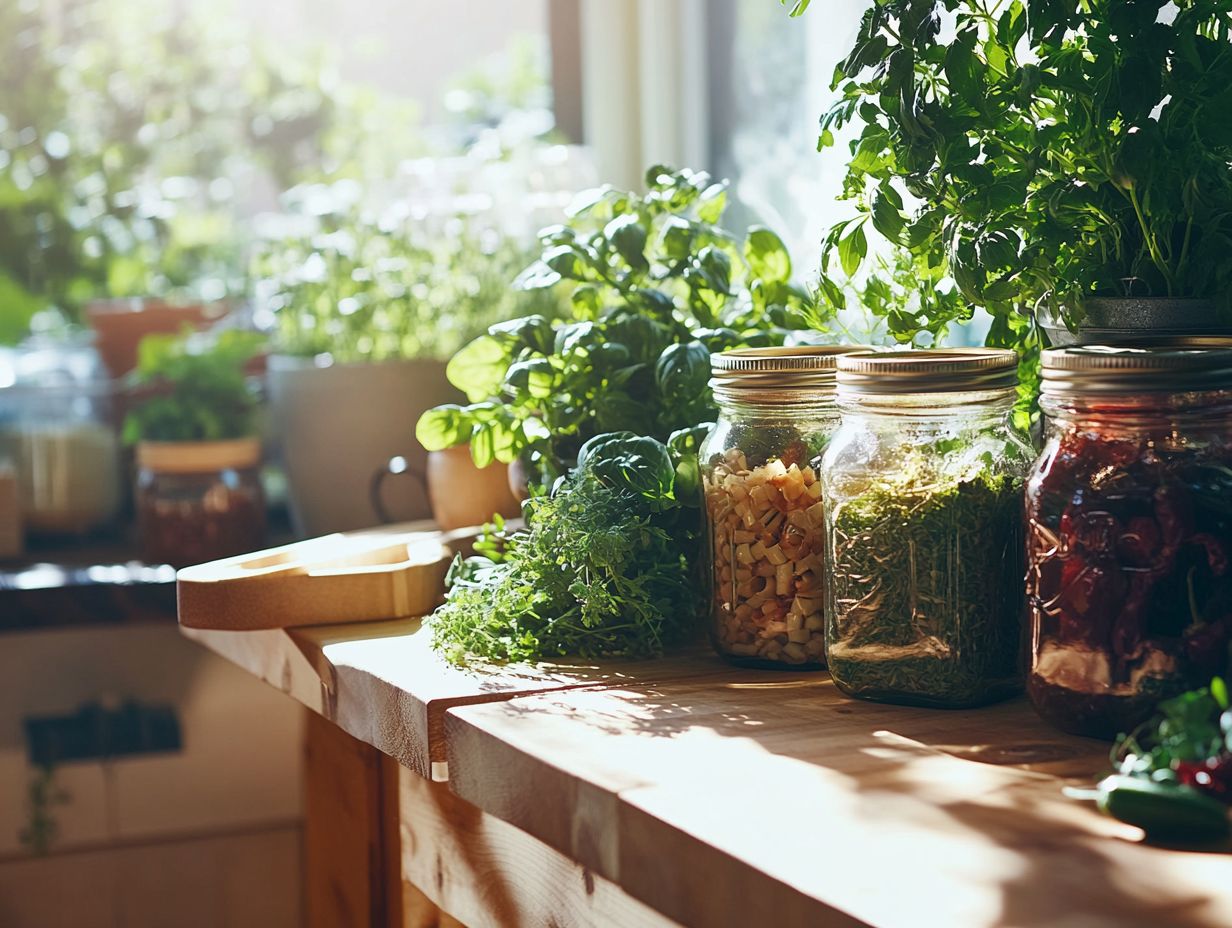
- Choose the right herbs for your canned foods to enhance flavor.
- Prepare herbs properly by harvesting and storing them for the best results.
- Use methods like infusion and drying to create unique flavors in your canned goods.
What is Canning and How Do Herbs Enhance It?
Canning is the process of preserving your favorite foods by sealing them in jars or containers. This method effectively prevents spoilage, allowing you to savor seasonal produce like delightful canned fruits and vegetables year-round.
The magic truly happens when you add herbs and spices. They elevate the flavor of your canned goods, transforming simple recipes into something remarkable while ensuring safety, especially when dealing with ingredients like tomatoes that require special care.
This method is supported by reputable organizations like the USDA and NCHFP, which provide invaluable guidance on best practices for home food preservation.
To achieve optimal results, you can choose from various canning methods, such as water bath canning or pressure canning. Water bath canning works well for high-acid foods like those luscious tomatoes blended with herbs while pressure canning is your go-to for low-acid items, which helps protect against harmful bacteria.
Experts like Elizabeth Andress stress the importance of following tested recipes to maintain the right acid levels for safe preservation.
Using your own homegrown herbs not only enhances flavor but also offers numerous health benefits. Food preservationist Eugenia Bone advocates for incorporating vibrant flavors to enrich your home canning experience. Always keep safety guidelines in mind to ensure that your preserved goods remain fresh and enjoyable.
Types of Herbs for Canning
In the world of canning, the herbs and spices you choose can significantly affect the final flavor. Selecting the right herbs is crucial for achieving the perfect balance of taste and preservation.
Homegrown herbs like basil, dill, and rosemary are particularly popular, adding their unique profiles to both pickling and vegetable preserving. By incorporating these fresh herbs, you can elevate your canned goods with delightful flavors that truly stand out.
Best Herbs for Different Types of Foods
Selecting the right herbs for your culinary creations is crucial for achieving that perfect flavor profile in your canned goods. For example, herbs like thyme and sage work wonders with vegetables, elevating their natural essence. Sweeter herbs, such as lavender particularly in the form of Lavender Sea Salt can transform canned fruits into something extraordinary, like Golden Plum Jam or Concord Grape Juice.
Consider the delightful freshness that basil and oregano can bring to your tomato-based sauces. They are ideal for crafting a tangy marinara or a rich tomato chutney. On the other hand, cilantro and lime zest add a vibrant kick to salsas, awakening the palate and making every bite exciting.
Balancing flavors is key, so don t hesitate to experiment with herbs like mint in sweet pickles or dill in carrot preserves. You’ll discover delicious combinations that will surprise your taste buds, making use of different herb drying techniques. By incorporating a range of herbs, you not only enhance the taste but also introduce unique aromas, turning ordinary dishes into gourmet delights that impress both your senses and your guests.
Preparing Herbs for Canning
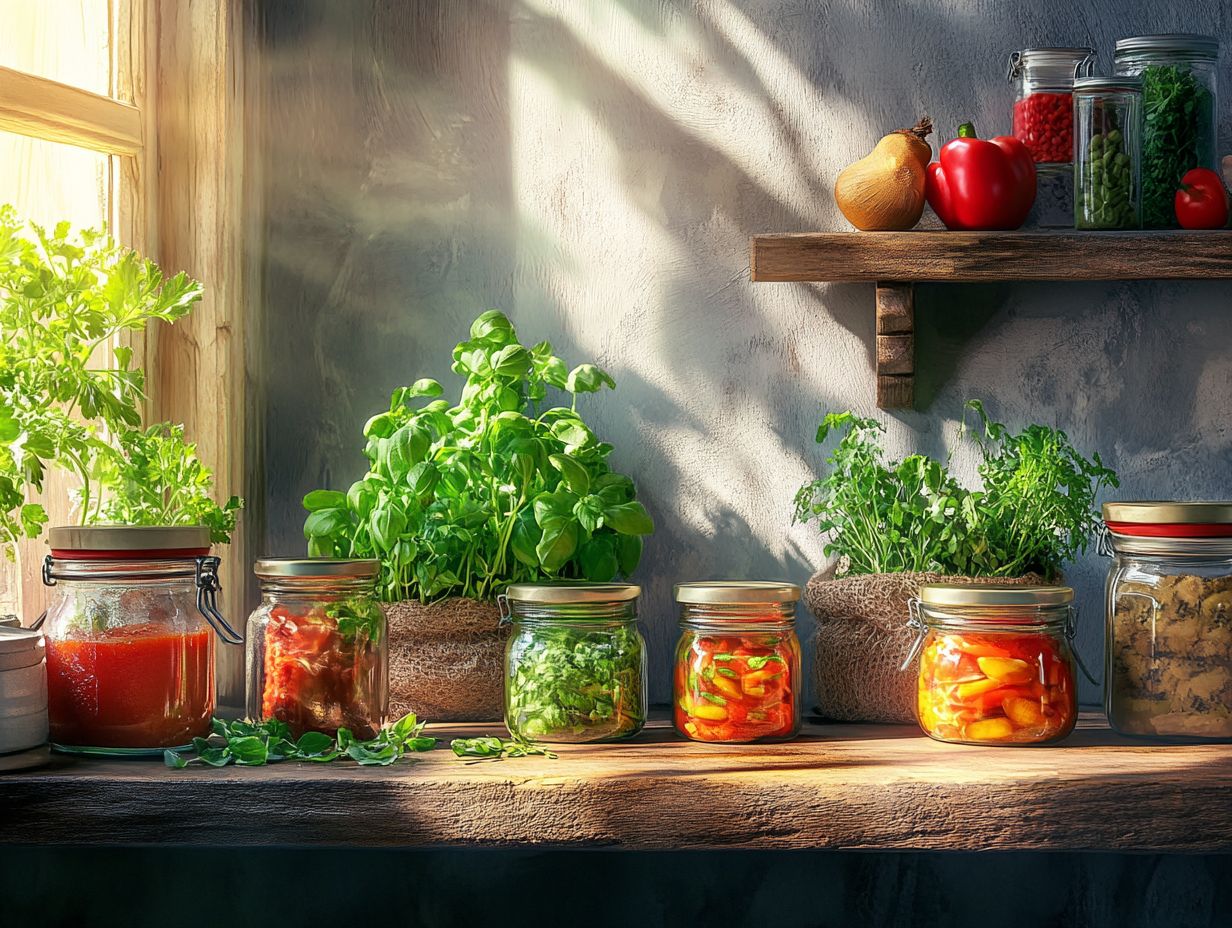
Prepare herbs properly for the best results in your canning process. Start with careful harvesting and extend through cleaning and storage.
When you harvest herbs, take the time to do so gently to ensure that their essential oils and flavors are preserved. After harvesting, thoroughly clean them to eliminate any dirt or impurities.
Employ appropriate storage techniques to maintain their freshness until you re ready to incorporate them into your home canning projects, especially when using Weck jars or a Home Canning Kit.
Harvesting, Cleaning, and Storing Herbs
Harvesting, cleaning, and storing herbs properly are crucial steps in ensuring their flavor and safety throughout the canning process. Start by harvesting your herbs in the morning when their essential oils are at their peak concentration.
Gently clean them under running water and dry them thoroughly before storing to prevent mold (a type of fungus) and preserve their strength.
As you clean, take a moment to scrutinize the herbs for any pests or impurities. After rinsing, lay them flat on a clean towel, allowing them to air dry for optimal freshness.
For storage, opt for airtight glass jars or vacuum-sealed bags to maintain that vibrant taste you desire, ensuring the flavor enhancement is at its peak.
In terms of drying, consider using an Excalibur Dehydrator for enhanced flavor retention, or stick with the simplicity and tradition of air drying. Each method has its unique advantages, influencing the final taste of your home-canned products, so choose wisely to ensure your culinary creations are as flavorful as they can be.
Methods of Incorporating Herbs in Canning
Incorporating herbs into your canning process can elevate your creations in remarkable ways. For detailed techniques, refer to the ultimate guide to canning herbs. You have several methods at your disposal—infusing, drying, or simply adding dried herbs to your recipes—each offering distinct flavor enhancements that can elevate your preserves.
Infusing means steeping herbs in a liquid to extract flavors, creating a robust foundation for pickling. Incorporating dried herbs directly into your canning recipes ensures a harmonious flavor throughout each jar. Embrace these techniques to transform your canning into a culinary art while following safety guidelines.
Ready to enhance your canning? Start experimenting with these herbs today!
Infusing, Drying, and Adding Herbs
Infusing, drying, and adding dried herbs can elevate the flavor of your canned goods. These techniques will make them truly stand out.
Infusing liquids with herbs creates a deep, aromatic base. Drying herbs allows for longer storage and enhances your recipes.
For infusion, simmer fresh herbs like basil or rosemary in olive oil or vinegar for a few hours. Strain out the solids for a rich, flavorful liquid.
When drying herbs, use fresh, moisture-free specimens. A dehydrator or low-heat oven preserves their oils while enhancing flavors.
Proper jar sealing is essential. Airtight seals protect against spoilage and keep your canned products vibrant.
Now, you can enjoy your culinary creations long after the harvest.
Tips for Successful Herb Canning
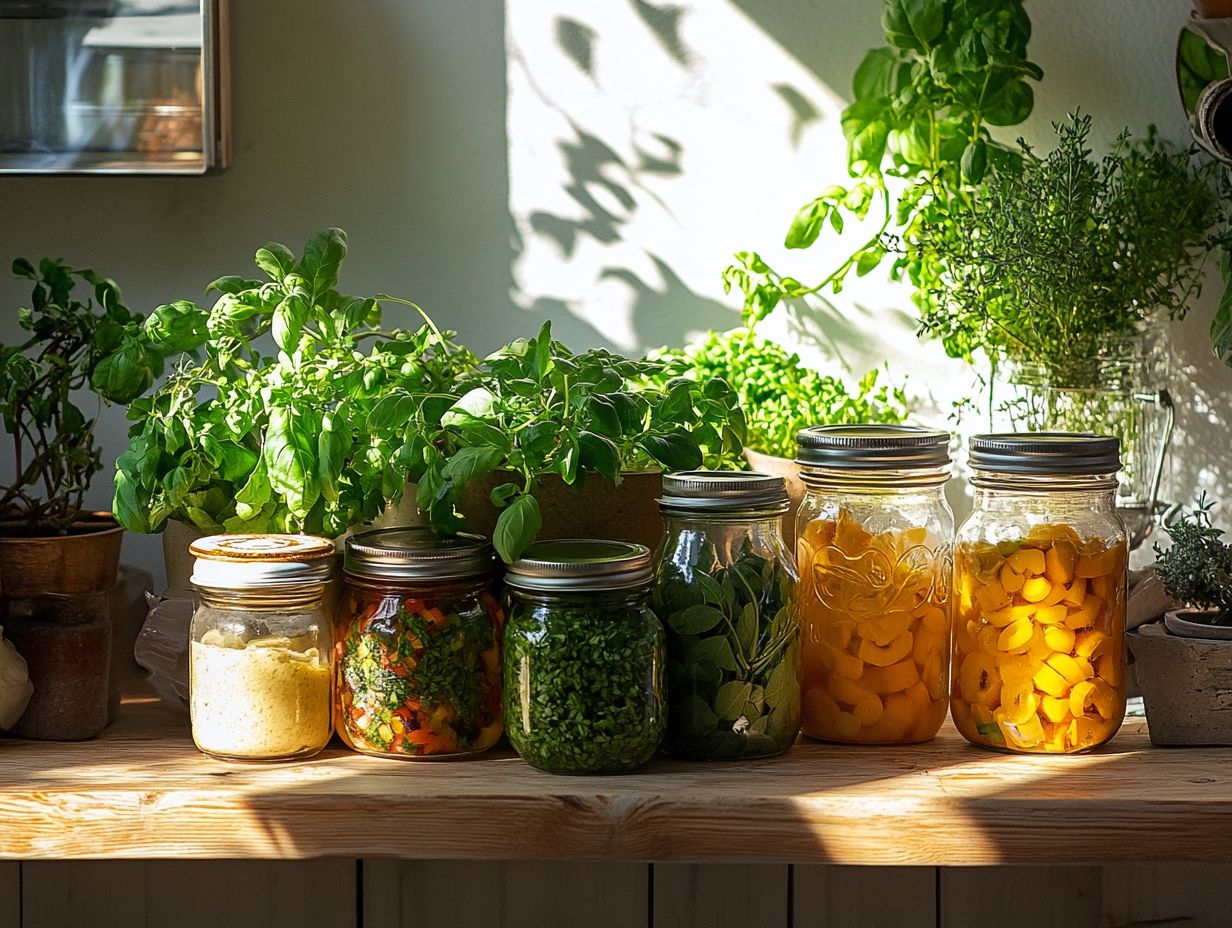
Successful herb canning requires a blend of creativity and a commitment to safety. Ensure your canned goods are flavorful and safe for consumption.
Follow food safety guidelines and learn the dos and don’ts of canning. This will help you preserve the freshness and quality of your creations.
Dos and Don’ts for Optimal Results
- Master the dos and don’ts for flavor and food safety.
- Always use fresh herbs and prepare them well.
- Research herb compatibility with acidic ingredients.
- Utilize proper canning techniques to prevent contamination and maintain quality.
- Neglecting food safety guidelines can lead to botulism, a serious illness caused by bacteria.
These practices boost the flavor of your canned herbs and ensure safety.
Recipes for Canning with Herbs
Explore recipes for canning with herbs for delicious possibilities. Elevate your home canning experience to new heights.
Imagine savory vegetable preserves infused with homegrown herbs. These recipes showcase the versatility of herbs and enhance flavors.
Delicious and Creative Ideas for Herb-Infused Canned Foods
Creating herb-infused canned foods opens up a world of delicious and creative ideas. These can elevate your home food preservation efforts. Picture yourself crafting Lavender Sea Salt pickles or savoring Low-Sugar Pepper Jelly infused with herbs. By experimenting with various flavor combinations, you can transform everyday canned fruits and vegetables into gourmet delights.
In this culinary journey, you’ll discover recipes that tantalize your taste buds. They also allow your creativity to shine. Get creative by infusing sweet peach preserves with a hint of thyme. Craft zesty tomato salsa enhanced by freshly chopped basil and oregano. These unique combinations enhance flavors and draw out the natural qualities of each ingredient.
As you dive into the preparation process, you’ll find that the canning method which refers to how you preserve food in jars provides a perfect opportunity to seal in those herbal notes. Water-bathing uses boiling water, while pressure canning employs high pressure to ensure safety. Both methods contribute to a rich, enduring taste experience.
Gather your favorite herbs and spices now! Embrace the art of flavor enhancement in your preserves!
Frequently Asked Questions
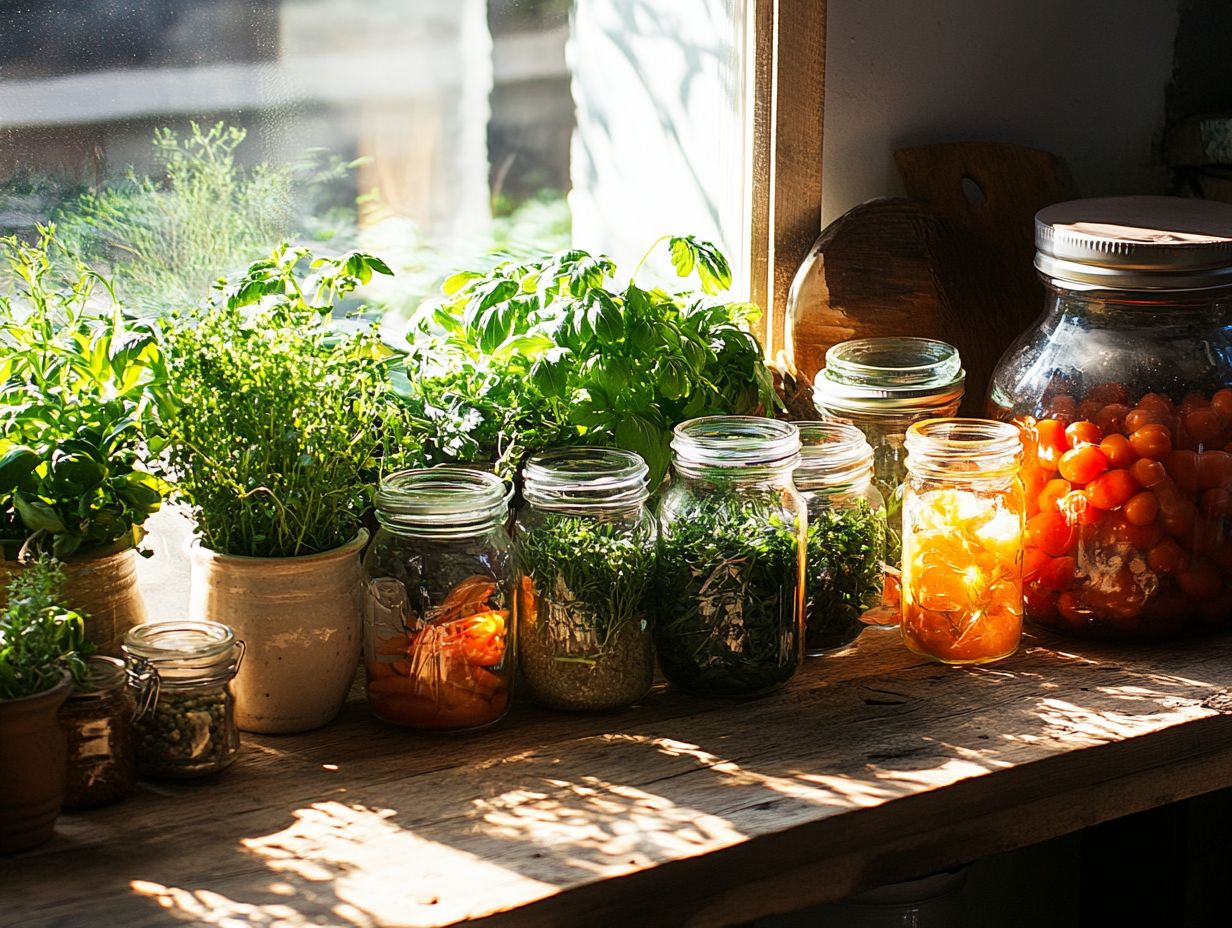
-
How do I incorporate herbs in canning?
To incorporate herbs in canning, you can either add them directly to the canned goods or explore how to use spices in canning techniques by infusing them into the liquid used for canning.
-
What herbs are best for canning?
Some popular herbs for canning include basil, thyme, rosemary, oregano, and dill. However, you can use any herbs you enjoy that complement the flavors of your canned goods.
-
Can I use dried herbs in canning?
Yes, you can use dried herbs in canning. Just keep in mind that dried herbs are more potent than fresh herbs, so you’ll need less in your recipes.
-
What is the best way to sterilize herbs for canning?
The best way to sterilize herbs is to blanch them in boiling water for a few seconds. Immediately transfer them to an ice bath to help preserve their color and flavor.
-
Can I mix different herbs together in canning?
Yes, you can mix different herbs together in canning as long as their flavors complement each other. Be mindful of the proportions to avoid overpowering flavors.
-
How long do herbs last in canned goods?
Herbs can last a long time in canned goods if properly stored. It is recommended to use them within 1-2 years for the best flavor and quality.

